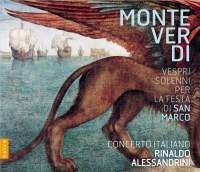Texte paru dans: / Appeared in:
*

GRAMOPHONE (Awards/2014)
Pour s'abonner /
Subscription information
Naïve
OP30557

Code-barres / Barcode : 0709861305575 (ID452)
Consultez toutes les évaluations recensées pour ce cd
~~~~ Reach all the evaluations located for this CD
 Gramophone (10/2014) Recording of the month
Gramophone (10/2014) Recording of the month
Reviewer:
David Vickers
Appearances can be deceptive, so be advised that this is not yet another version of the 1610 Vespers. These proceedings commence with a stately performance of that collection’s famous opener, ‘Domine ad adiuvandum me festina’, but what follows is a broad range of the composer’s later Venetian church music composed during his three-decade tenure as maestro di cappella at St Mark’s Basilica. Monteverdi was unceremoniously sacked from his job at the Gonzaga court in Mantua in July 1612, but fortunately the most prestigious musical job in northern Italy became available when the maestro di cappella of St Mark’s died. On August 1, 1613, Monteverdi auditioned for the vacancy by rehearsing a Mass with about 50 musicians in the church of San Giorgio Maggiore; the procurators were so impressed that they hired him on the spot.
Concerto Italiano’s welcome return to Monteverdi’s sacred music is apparently the first volume in a new series that will explore the composer’s monumental anthology Selva morale e spirituale, the ‘moral and spiritual forest’ of sacred music ‘Concerto Italiano navigate their way skilfully through the grandeur, intimacy, drama and textural subtlety of the music’ published in Venice in 1641, just two years before his death; Rinaldo Alessandrini and Naïve’s documentation both cite the title-page’s year of 1640, although Monteverdi’s dedication is dated May 1, 1641; the dedicatee was none other than Eleonora Gonzaga – the daughter of his first Mantuan employer Duke Vincenzo I and widow of Habsburg Holy Roman Emperor Ferdinand II. The publication contains 37 different pieces, including spiritual madrigals (essentially ‘vanitas’ texts), psalms (some of them in up to three different settings), music for the Mass, hymns and more. We do not know when or why these diverse works were originally created, nor can we be certain they were all necessarily for feast days, Masses, Vespers and other ceremonies at St Mark’s: we know Monteverdi provided sacred music for special occasions at plenty of other venerable Venetian institutions. Given the impossibility of connecting specific pieces with precise dates and places, any kind of liturgical reconstruction has to be considered as nothing other than an informed speculative context that enables us to experience these magnificent works beyond their secularised modern function as concert items.
Alessandrini offers a digestibly
programmed experience of a single plausible liturgical context of the festival
of St Mark the Evangelist (which takes place on April 25). Accordingly, a
selection of suitable psalms, motets and a large-scale Magnificat are placed
within chants and responses that Alessandrini claims are drawn ‘from the liturgy
in use at St Mark’s in Monteverdi’s time’ (he does not specify his sources for
this – but the plainchant texts make for a fascinating change from the usual
rite). In the event, half of the plainsong antiphons are substituted for
assorted instrumental sonatas by various composers and Monteverdi’s motets
Christe, adoramus te and Cantate Domino, both from a collection printed by
Bianchi in 1620; these are often performed by a simple combination of choir and
organ, but instead Concerto Italiano’s small consort of experienced voices are
doubled by solemnly grand trombones.
The recording, made at the Basilica Santa Barbara in Mantua, is probably the
closest we will ever get to an authentic Monteverdian venue free from crowds of
noisy tourists. It has been used as a venue for memorable recordings before,
such as Jordi Savall’s 1610 Vespers (Alia Vox, 2/92) and, more recently,
Odhecaton’s sublime recording of the Missa In illo tempore (Ricercar). The
resonant yet exquisitely transparent acoustic weaves its spellbinding magic on
the single voices and accomplished instrumentalists of Concerto Italiano, who
navigate their way skilfully through the grandeur, intimacy, rhetorical drama
and textural subtlety that the music demands at the drop of a hat. Much of the
music-making has perfect conversational qualities, especially in the interplay
between the concertante solo voices and the blossoming textures of the ripieno
groups (the climax to the Magnificat is thrilling stuff).
Those wanting to hear only Monteverdi’s masterpieces without plainchants and liturgical considerations are already well served by versions such as the recently completed series by The Sixteen (not quite complete and spread across three separate volumes – Coro) and Cantus Cölln (the only totally comprehensive version that’s safely recommendable – Harmonia Mundi). However, La Venexiana (Glossa) and Akadêmia (Zig-Zag) both place the majority of Selva morale within different liturgical programmes (neither excellent set included the five moral madrigals – a real pity). It remains to be seen how Alessandrini’s project might differ from other surveys of this wonderful repertoire: he has never been a mere copier of formulas and his healthy approach to pickand-mix repertoire promises to construct a valuable new framework for these oft-recorded pieces.
The bonus DVD entitled ‘The Human and the Divine’ is nothing to write home about; it might be better to avoid watching the fly-on-a-wall footage of Alessandrini and his hosts after dinner rambling on about Monteverdi’s Neoplatonism, and some speculations presented as hard fact will cause scholars to raise their eyebrows. Nevertheless, there is some engaging footage of the Ducal Palace in Mantua and a film of the performers at work in S Barbara. The recording itself is really the focus of attention, and Concerto Italiano’s distinguished performances constitute their most essential Monteverdian work in donkey’s years.
Cliquez l'un ou l'autre
bouton pour découvrir bien d'autres critiques de CD
Click either button for many other reviews


